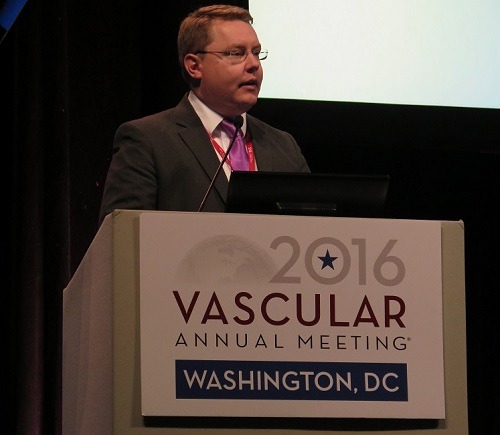
New US research indicates that there was a widespread and steady decline in elective open abdominal aortic aneurysm repairs for Medicare patients from 2003 to 2013, coinciding with a “dramatic” substitution of endovascular aneurysm repair (EVAR) across all geographic areas and a strikingly fast adoption of branched/fenestrated EVAR.
Bjoern Suckow, Dartmouth-Hitchcock Medical Center, Lebanon, USA, presented the data at the Vascular Annual Meeting (9–11 June, National Harbor, USA), telling delegates that branched/fenestrated EVAR has seen a “diffuse and rapid adoption” across the USA, with a potential substitution effect for EVAR and comparable mortality rates.
Suckow explained that the “disruptive innovation” of endovascular approaches, and branched/fenestrated EVAR in particular, could manifest as an additive (increase in overall repairs by offering repair for otherwise unfit candidates) or substitution (replacing open repair or replacing EVAR in patients with short aortic necks) effect.
In an attempt to chart the changing rates of open, EVAR and branched/fenestrated EVAR repairs over the past decade, Suckow and colleagues used a query of Medicare claims data from 2003–2013 involving abdominal aortic aneurysm repairs (excluding open repairs with any thoracic component but including juxta-/pararenal procedures).
The data gathered showed a 20% decline in all forms of abdominal aortic aneurysm repair to approximately 24,000 repairs in 2013 following a peak of approximately 30,000 in 2005. Breaking these figures down by procedure type, the number of EVAR procedures grew by 74% from 2003–2008 before falling by 13% to 2013. Open repair saw a prolonged and significant decline from 2003 to 2013, falling by 78%. Less than 4,000 open repair Medicare procedures were completed in 2013, Suckow said. Branched/fenestrated EVAR—first coded by Medicare in 2011—has since increased by 504% and by 2013 was as common as open repair.
As well as looking at the total number of repairs, the team also looked at rates of repair across the USA. They found that from 2003 to 2013, the rate of abdominal aortic aneurysm repair per 100,000 patients decreased across all regions. EVAR rate over the same period rose in almost all regions, whereas open repair dropped dramatically, with one third of US regions performing too low a number of procedures to even generate a rate per 100,000 patients. Branch/fenestrated EVAR rates in 2013 saw “significant regional variation across the country,” Suckow said, with most procedures undertaken by early-adopting centres. In-hospital mortality was approximately 10% for open repair patients during this period (though this rate includes juxta- and pararenal repairs, possibly contributing to a higher mortality rate), compared with 2–3% for EVAR. For branched/fenestrated patients, the mortality was also 2–3%, which was not significantly different to EVAR.
“Our study has important implications,” Suckow explained. “First, our study presents challenges for training for both open, as well as branched/fenestrated techniques. The study raises the question of whether such treatments will ultimately need to be performed only at centres of excellence. Second, the rapid adoption of branch/fenestrated EVAR necessitates ongoing evaluation regarding its long-term durability and outcomes.”













